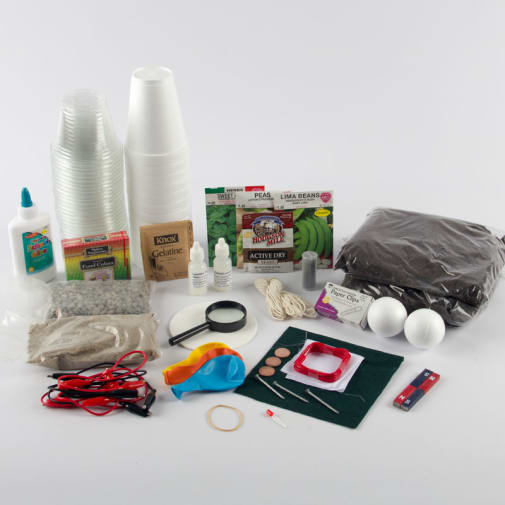Kit includes clear plastic cups, poly bags, filter paper, coarse sand, food coloring, laundry starch, pebbles, school glue, paper clips, yeast, magnifying glass, blotter paper, rubber band, seeds (peas, baby lima beans and sweet basil), alligator clip leads, copper pieces and wire, red LED, galvanized nails, balloons, silk and wool friction pads, heavy cord, Styrofoam balls, bar magnets, styrofoam cups, iron metal fillings, peat moss, and unflavored gelatin. You will need to provide colored pencils, citrus dish degreaser, measuring cups and spoons, permanent black marker, round tip scissors, science notebook, scalpel (knife), digital stopwatch (or watch with second hand/cell phone timer), glucose syrup (or corn syrup), and dry ice. Optional items include Bird Golden Guide, Marigold seeds, Stellar scope Star Locator, and chemical splash safety googles (for block dry ice).
Exploring the Building Blocks of Science Book 3 Kit
- Small parts. Not for children under 3 years.
Description
This kit contains over 30 items for experiments in the Building Blocks of Science Book 3, including laundry starch, balloons, friction pads, peat moss, various seeds, magnifying glass, gelatin and so much more! Use the materials included in this kit to explore various hands-on topics including polymers, DNA, mixtures, the basic cell, photosynthesis, how electricidal energy and magnets work, Earth’s magnetic field, galaxies and more!
Kit Contents: Filter Paper, 11 cm, 10 pack; Food Coloring, 4 colors; Iron Metal Filings, 30 g; Laundry Starch, concentrated, 60 mL; Alligator Clip Leads, 6 pack; Copper Pieces, 3 pack; LED, red, diffuse type, 5 mm; Copper Wire, insulated, #24, 15'; Balloons, medium, 9", 3 pack; Friction Pad, silk, 6x6"; Friction Pad, wool, 6x6"; Paper Clips, small, 100/box; Peat Moss, 2 bags;Pebbles, fine gravel, 1 lb.; Sand, coarse, 1 lb; Seeds, sweet basil, pack; Seeds, baby lima bean, pack; Seeds, pea, pack; Yeast, packet; String, heavy cord, 25'; Bar Magnets, 3"" Alnico I, 2 pack; Magnifying Glass, 2", 3X Lens; 6x10 Poly Bags, 1.5 mil, 3 pack (not pictured); Paper, blotter, one 12"x18" sheet; Cup, clear plastic, 9 oz, 30 pack; Gelatin, unflavored; Nail, 6D galvanized box, 3 pack; Rubber Band, size 16; School Glue, 4oz; Styrofoam Ball, 2"" diameter, 2 pack; Styrofoam Cup, 12 oz, 12 pack
Topics in Book 3 include: mixtures, polymers, DNA, plants, the plant life cycle, hydrosphere, biosphere, earth's magnetic field, galaxies, celestial objects, electricity, magnets, and more. A typical week includes reading the chapter, performing the experiment, and review.
| Product Format: | Other |
|---|---|
| Grade: | 3 |
| Brand: | Home Science Tools |
| Length in Inches: | 19.25 |
| Width in Inches: | 13.625 |
| Height in Inches: | 5.375 |
| Weight in Pounds: | 7.0313 |

